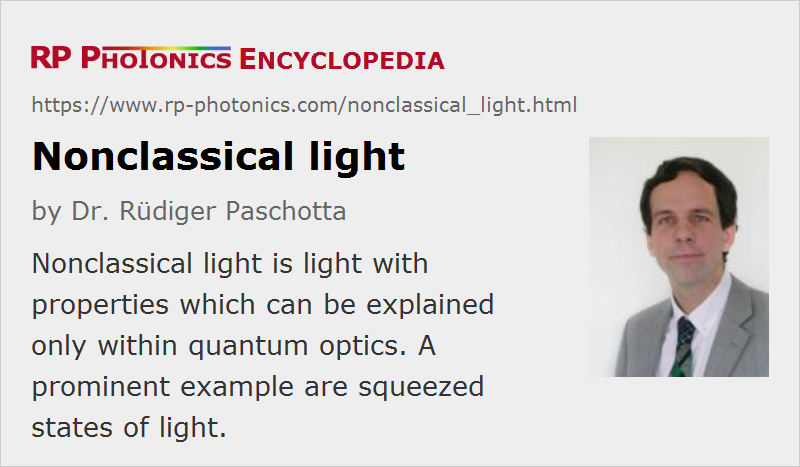Nonclassical Light
Definition: light with properties which can be explained only within quantum optics
More general terms: light
German: nichtklassisches Licht
Categories: quantum optics, fluctuations and noise
How to cite the article; suggest additional literature
Author: Dr. Rüdiger Paschotta
Nonclassical light is light with nonclassical quantum noise properties, which can be understood only on the basis of quantum optics. The most common forms of nonclassical light are the following:
- Squeezed light exhibits reduced noise in one quadrature component. The most familiar kinds of squeezed light have either reduced intensity noise or reduced phase noise, with increased noise of the other kind.
- Fock states (also called photon number states) have a well-defined number of photons (stored e.g. in a cavity), whereas the phase is totally undefined. A special case is that of a single-photon state, as generated on demand by a photon gun.
- Nonclassical light sometimes exhibits photon antibunching, i.e. a reduced probability of two photons being detected within a short time interval, or sub-Poissonian photon statistics.
- Also, there are states with special correlations between two or more different light beams. For example, signal and idler in parametric amplification exhibit strong intensity noise correlations, because signal/idler photons are generated in pairs. Nonclassical correlations of different light beams also occur in the context of quantum nondemolition measurements.
Nonclassical light is often generated either in nonlinear devices such as in sub-threshold optical parametric oscillators or frequency doublers, or in systems with only a single atom or ion (or just a few such emitters), such as a single-atom laser. It is relevant in fundamental quantum physics and also in the context of some high-precision measurements, such as for gravitational wave detection.
Questions and Comments from Users
Here you can submit questions and comments. As far as they get accepted by the author, they will appear above this paragraph together with the author’s answer. The author will decide on acceptance based on certain criteria. Essentially, the issue must be of sufficiently broad interest.
Please do not enter personal data here; we would otherwise delete it soon. (See also our privacy declaration.) If you wish to receive personal feedback or consultancy from the author, please contact him e.g. via e-mail.
By submitting the information, you give your consent to the potential publication of your inputs on our website according to our rules. (If you later retract your consent, we will delete those inputs.) As your inputs are first reviewed by the author, they may be published with some delay.
Bibliography
| [1] | R. J. Glauber, “Coherent and incoherent states of the radiation field”, Phys. Rev. 131 (6), 2766 (1963), doi:10.1103/PhysRev.131.2766 |
| [2] | D. Walls, “Squeezed states of light”, Nature 306, 141 (1983), doi:10.1038/306141a0 |
| [3] | H. J. Kimble and D. Walls (eds.), Special Issue on Squeezed Light, J. Opt. Soc. Am B 4 (10) (1987) |
See also: quantum optics, quantum noise, squeezed states of light, parametric amplification, single-atom lasers
and other articles in the categories quantum optics, fluctuations and noise
 |





If you like this page, please share the link with your friends and colleagues, e.g. via social media:
These sharing buttons are implemented in a privacy-friendly way!